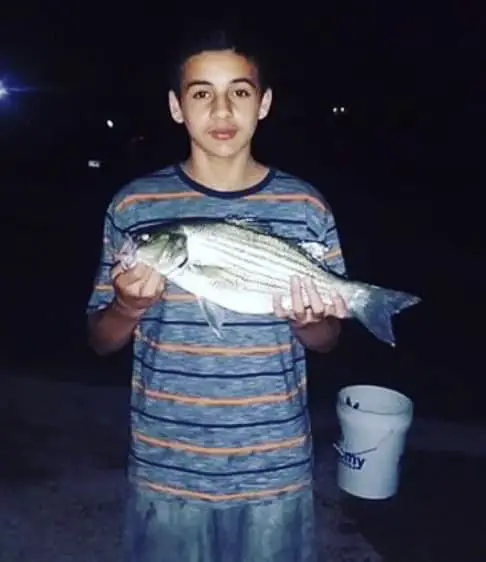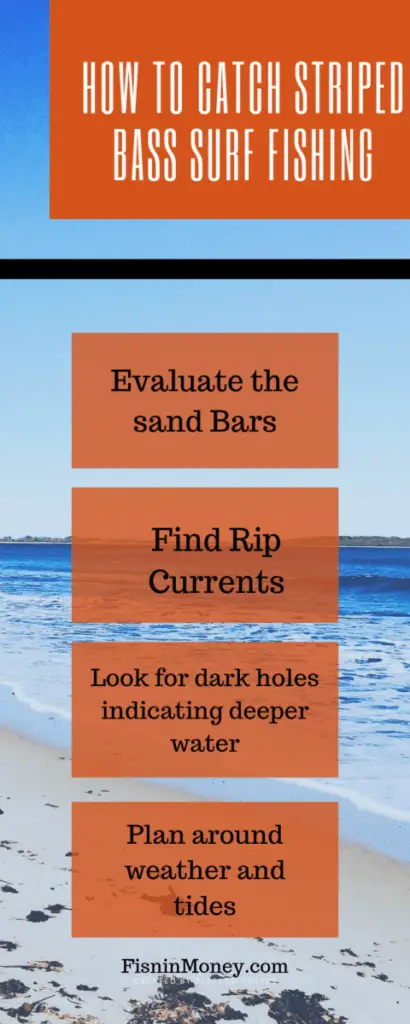Surf fishing by definition on Wikipedia; the sport of catching fish standing on the shoreline or wading in the surf. It may or may no include casting bait or a lure, and refers to all types of shore fishing – from sand and rocky beaches, jetties or even fishing piers.

Some anglers feel they are restricted when they are fishing from dry land, but you aren’t. You can catch striped bass from shore. If you are trying to save up for a boat, or you are just short on money, rest assured that you can fish in saltwater from dry land and still catch good sized stripers. We will review some tips, techniques, places, rods, reels, and bait that is best for surf fishing for striped bass. So, lets get started on learning all about surf fishing for striper.
As a beginner, you need to understand how to surf cast. This method is a lot like regular casting, but you are going more for distance and accuracy with surf casting. The main tip/trick that anglers can give a beginner is to figure out the speed and power to get your line out as accurate as possible. It is best to have your one arm at a 90 degree angle and the other one straight. As you get your cast down, you can begin to try different lures or live bait for the striper and experiment with different areas and times of the day.
The ocean can be intimidating or even scary for a new surf caster, but you will have to take some time to learn a little bit, as far as reading the beach. Try to relax, and follow what other fishermen are doing. Here are a couple of tips to help you figure out where a prime spot may be to surf fish for striper.
- Evaluate the sand Bars
- Find Rip Currents
- Look for dark holes indicating deeper water
- Plan around weather and tides
1. Evaluate the sand bar. Sand bars change with the waves and will indicate whether the striped bass are close to the shore or behind the sand bar chasing bait. Look for where the waves begin to split as they are coming in.
2. Rip currents are the breaks in the sand bar where stripers will come in to feed. Try casting your line to either side of the rip current or outflow, striped bass are smart and don’t always come up the middle.
3. Look for shells and course sand when exploring the beach. This indicates close-by areas that have bigger holes to hold the fish, under water. Subtle as it may seem, you want to keep an eye on this as it can have a huge effect on your surf fishing for striped bass.
4. There are other things you will need to learn to become a better surf caster. Besides reading the beach, you will need to learn how the weather and tides affect surf fishing. Here are 3 general rules of thumb to keep in mind:
A. Overcast or rainy days. This makes your fishing line harder to detect, making your bait more appealing to the striped bass. But keep a close eye on the weather, when surf fishing, thunderstorms and high winds can be very dangerous.
B. During high tides, especially at dawn and dusk, there will be more feeding stripers. Check local tide reports and fishing reports to get a feel for what the striped bass like best, high tide or low tide, and when the time-frame is for both.
C. Use the low-tide to your advantage. This is the best opportunity to locate dips, hollows, and sand banks.
5. Gear you will need to take with you when you decide to give surf fishing for striped bass a try for the first (or second time); saltwater rod and reel, tackle and bait, net, knife, bait bucket, spare line, pliers, tape measure, rain gear, sunscreen/glasses, first aid kit, and of course, your fishing license.
The proper gear will make your fishing experience enjoyable, but you have to remember it is going to take practice and patience. The more you learn about and the more you fish for striped bass, the more experience you gain and the easier surf fishing will become. It takes time, research, trial and error for everyone to learn something new.
Spring Striper Spawning Run
Jumping ahead a little bit now. From September to December anglers from all over the United States risk getting fired from their jobs, getting a divorce or losing their homes, to participate in the biggest striper fishing event of the year. From beginners to expert, they come to line the shores and wade the waters from Massachusetts to the Jersey Shore. Why you ask? What is so important, that someone would be willing to possibly lose everything? It is for the fall striper run!!
Everyone is in hot pursuit of a giant striped bass. Montauk in New York is one of the busiest spots during the fall run. They have impeccable prime hot spots at any time of the year. A 50 pound striper, when you are surf fishing is considered a benchmark fish, many of them can be caught at Montauk. Long Island is another area that is centrally located for the fall migration. On the North and South shores and on the Point, bait fish run in extremely big schools. When surf casting this area for striped bass a 1 to 4 ounce white buck tail tipped with a pork rind is most used and recommended. (Here are examples) It will withstand the rocky structures. Some anglers say that you can plant your feet in the sand and catch trophy sized stripers but it is a BIG commitment that you have to be invested in 110%.
Surf fishing for striped bass is more of a cold weather endeavor, preferring 50-65 degree temperatures. In warmer areas of the United States you are better off looking in freshwater lakes and rivers. One angler will say that live bait works best for surf casting. If you are going to use artificial lures to surf fish, then he suggests eels and squid. Some say a spinning reel is the best, because you have less issues. But, even a bait casting reel is just fine too. Ten to twelve foot rods are recommended, but is definitely not a must. You can use what you are most comfortable with, there is no need to buy any special rods or reels for surf fishing. Make sure you have a pair of waders as well. The surf fishing experience will be more enjoyable if your feet are not wet up to your knees. Make sure they are light weight and durable, 100% rubber will be too heavy.

Striped Bass Surf Fishing at Night
Night surf fishing has its own rewards. One of which, striped bass are more willing to feed closer to shore in the darkness. But a challenge to fishing at night, depending on how late you are out, you will be fishing by pure sight and feel. Some welcome the challenge of darkness, while others may not be so eager to be in pitch black conditions. It all depends on how comfortable you are in darkness and how confident you are in your ability to surf fish for striped bass.
If you decide to surf fish in the Upper Cape Cod Bay make sure to bring your patience. The two best times for striped bass to be close to the shore for surf casting is in May and October. One expert states that there is only 2 ways to surf fish from the sand in this area.
1. Select a stretch of the beach and just cast and walk. Since the fish could be anywhere, covering as much ground as possible is the best. Once you get a bite, you can be assured you have come across the school of striped bass. Do keep in mind that there are many miles of coastline in Upper Cape Cod, so odds are stacked against you.
2. The other way to surf fish for stripers is to pick a stretch of beach, cast out some chum bait and wait for the schools to come to you. Both techniques work and both techniques pose a certain amount of challenge, which attracts a lot of anglers to this area for surf fishing for striped bass.
Striper Surf Fishing Gear
As mentioned above, 10-12 foot rods are recommended. If you are surf fishing where the deeper water is closer to you, you can get away with an 7 or 8 foot rod. A 4 or 5 ounce sinker is perfect to use if the surf is “normal”. If the surf is rough you may have to use a 6-8 ounce sinker and you will definitely want a stiffer rod It is a personal preference on the type of reel you use, spinner or conventional. But make sure you have a line capacity of at least 250 yards.
As for fishing line, that is also going to be more of a personal preference. Some anglers prefer 30 pound test braid, while others opt for 14-20 pound monofilament. You may also want to consider korkers for your surf fishing endeavor, especially if you are going to be standing in the water.
All fisherman have a different idea or preference when it comes to tackle. There are an abundance of manufacturers that offer great surf fishing equipment for your striped bass excursion. But, no matter what rod, reel, line, and bait you choose make sure that you lightly rinse off all equipment after fishing in saltwater.
Hey FISHMONGER – make sure to check out my FISHING RESOURCES page.
Striped Bass Surf Fishing Best Spots
Just a few of the most popular surf fishing hot spots for striped bass; Cape Cod, Montauk, Charleston, SC, Chesapeake Bay, and Myrtle Beach. The fishing is great in all of these areas, and if you choose to make it a family vacation and there are others who are not into fishing, there will be plenty for them to do as well; sight seeing, amusement parks, movies, malls and much more depending on the area.
So there you go. Some of the best information for you to go striped bass fishing (surf casting) in the surf. The most important things are; check the rules, regulations, and keeper limit. Also make sure you are safe, as the wind and weather can cause for strong hard surf conditions. Don’t forget your waders, wader belt (to make sure no water gets in your boots), and your korkers (for grip on the bottom of your waders). Pack a rain coat and sunscreen and sun glasses because you never know, even checking the weather report, when things can change from one extreme to the next. Double check that you have your rod, reel, extra fishing line, artificial bait, pliers and a cooler to keep your fish in. You can purchase any live bait you wish to use at the local bait and tackle shops in the area.
If you are a beginner; make sure that you do your research on surf fishing (surf casting), visit with the locals to get their tips and suggestions on the best spots and what to watch out for. Make sure you also keep an eye on the weather and the fishing reports, those will also give you a lot of useful information. If you are still unsure, hire a fishing guide. Then you will have a professional right there with you, teaching you the very best and easiest way to surf fish for striped bass. They are the ones who are going to know the ends and outs of the area, the habitat of the stripers, the best live bait or artificial lures to use, and the tide/surf.
Now that I have covered the safety things you need to do and the must-haves to take with you surf fishing for stripers, lets make those reservations for the motel/hotel or at the RV park and get those suitcases all packed up. This will be fun for the whole family and a definite learning experience for you . Please be safe, take care and Tight Lines!


